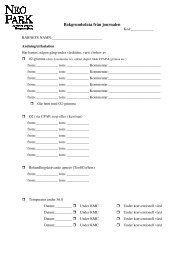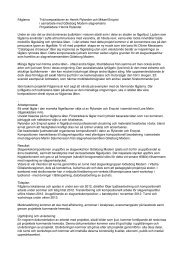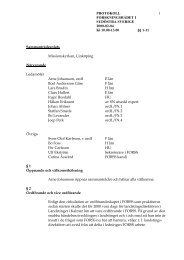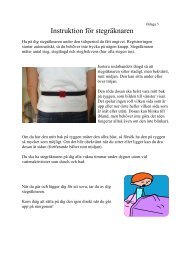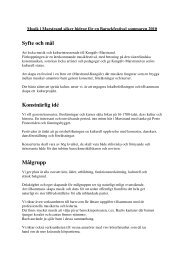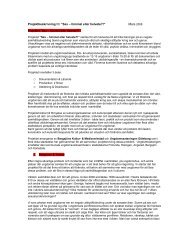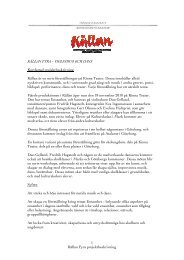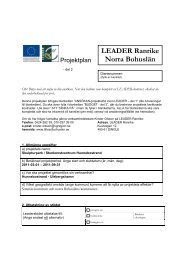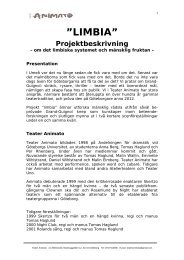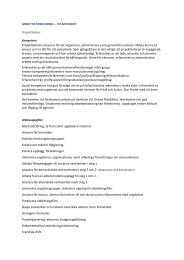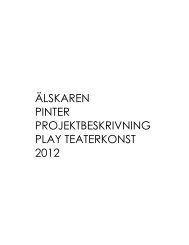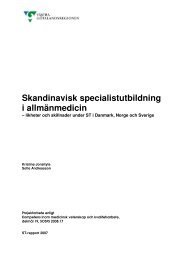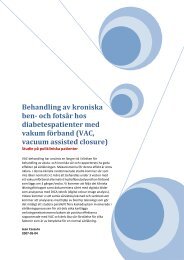SUMMARY OF ABBREVIATIONS
SUMMARY OF ABBREVIATIONS
SUMMARY OF ABBREVIATIONS
You also want an ePaper? Increase the reach of your titles
YUMPU automatically turns print PDFs into web optimized ePapers that Google loves.
Growth Hormone for Heart Failure Trial Appendix I<br />
Sahlgrenska University Hospital<br />
2003-03-26<br />
<strong>SUMMARY</strong> <strong>OF</strong> <strong>ABBREVIATIONS</strong><br />
AE adverse event<br />
AHA American Heart Association<br />
ALAT alanine amino transferase<br />
ALP alkaline phosphatase<br />
ANP atrial natriuretic peptide<br />
BNP brain natriuretic peptide<br />
ASAT aspartate amino transferase<br />
AV atrioventricular<br />
CHF congestive heart failure<br />
CRF case report form<br />
ECG electrocardiogram<br />
EF ejection fraction<br />
GH growth hormone<br />
HDL high density lipoprotein<br />
ICD internal cardiovertor defibrillator<br />
ISMC independent safety monitoring committee<br />
IGF-I insulin-like growth factor I<br />
IGFBP-3 insulin-like growth factor binding protein 3<br />
IRMA immuno radio metric assay<br />
IVC inferior vena cava<br />
LAO left anterior oblique<br />
LDL low density lipoprotein<br />
LPC leukocyte particle count<br />
LV left ventricle<br />
LVEF left ventricular ejection fraction<br />
LVESV left ventricular end systolic volume<br />
LVEDV left ventricular end diastolic volume<br />
MRI magnetic resonance imaging<br />
NYHA New York Heart Association<br />
QoL quality of life<br />
RIA radioimmunoassay<br />
ROI region of interest<br />
SF-36 short form 36<br />
WHO World Health Organisation
Growth Hormone for Heart Failure Trial Appendix III<br />
Sahlgrenska University Hospital<br />
2003-03-26<br />
WORLD MEDICAL ASSOCIATION DECLARATION <strong>OF</strong> HELSINKI<br />
Ethical Principles for Medical Research Involving Human Subjects<br />
Adopted by the 18th WMA General Assembly Helsinki, Finland, June 1964 and amended by the 29th WMA General Assembly, Tokyo, Japan, October<br />
1975 35th WMA General Assembly, Venice, Italy, October 1983 41st WMA General Assembly, Hong Kong, September 1989 48th WMA General<br />
Assembly, Somerset West, Republic of South Africa, October 1996 and the 52nd WMA General Assembly, Edinburgh, Scotland, October 2000<br />
A. INTRODUCTION<br />
1. The World Medical Association has developed the Declaration of Helsinki as a statement of ethical principles to provide guidance to physicians and<br />
other participants in medical research involving human subjects. Medical research involving human subjects includes research on identifiable human<br />
material or identifiable data.<br />
2. It is the duty of the physician to promote and safeguard the health of the people. The physician's knowledge and conscience are dedicated to the<br />
fulfillment of this duty.<br />
3. The Declaration of Geneva of the World Medical Association binds the physician with the words, "The health of my patient will be my first<br />
consideration," and the International Code of Medical Ethics declares that, "A physician shall act only in the patient's interest when providing medical<br />
care which might have the effect of weakening the physical and mental condition of the patient."<br />
4. Medical progress is based on research which ultimately must rest in part on experimentation involving human subjects.<br />
5. In medical research on human subjects, considerations related to the well-being of the human subject should take precedence over the interests of<br />
science and society.<br />
6. The primary purpose of medical research involving human subjects is to improve prophylactic, diagnostic and therapeutic procedures and the<br />
understanding of the aetiology and pathogenesis of disease. Even the best proven prophylactic, diagnostic, and therapeutic methods must continuously<br />
be challenged through research for their effectiveness, efficiency, accessibility and quality.<br />
7. In current medical practice and in medical research, most prophylactic, diagnostic and therapeutic procedures involve risks and burdens.<br />
8. Medical research is subject to ethical standards that promote respect for all human beings and protect their health and rights. Some research<br />
populations are vulnerable and need special protection. The particular needs of the economically and medically disadvantaged must be recognized.<br />
Special attention is also required for those who cannot give or refuse consent for themselves, for those who may be subject to giving consent under<br />
duress, for those who will not benefit personally from the research and for those for whom the research is combined with care.<br />
9. Research Investigators should be aware of the ethical, legal and regulatory requirements for research on human subjects in their own countries as<br />
well as applicable international requirements. No national ethical, legal or regulatory requirement should be allowed to reduce or eliminate any of the<br />
protections for human subjects set forth in this Declaration.<br />
B. BASIC PRINCIPLES FOR ALL MEDICAL RESEARCH<br />
10. It is the duty of the physician in medical research to protect the life, health, privacy, and dignity of the human subject.<br />
11. Medical research involving human subjects must conform to generally accepted scientific principles, be based on a thorough knowledge of the<br />
scientific literature, other relevant sources of information, and on adequate laboratory and, where appropriate, animal experimentation.<br />
12. Appropriate caution must be exercised in the conduct of research which may affect the environment, and the welfare of animals used for research<br />
must be respected.<br />
13. The design and performance of each experimental procedure involving human subjects should be clearly formulated in an experimental protocol. This<br />
protocol should be submitted for consideration, comment, guidance, and where appropriate, approval to a specially appointed ethical review committee,<br />
which must be independent of the investigator, the sponsor or any other kind of undue influence. This independent committee should be in conformity<br />
with the laws and regulations of the country in which the research experiment is performed. The committee has the right to monitor ongoing trials. The<br />
researcher has the obligation to provide monitoring information to the committee, especially any serious adverse events. The researcher should also<br />
submit to the committee, for review, information regarding funding, sponsors, institutional affiliations, other potential conflicts of interest and incentives<br />
for subjects.<br />
14. The research protocol should always contain a statement of the ethical considerations involved and should indicate that there is compliance with the<br />
principles enunciated in this Declaration.<br />
15. Medical research involving human subjects should be conducted only by scientifically qualified persons and under the supervision of a clinically<br />
competent medical person. The responsibility for the human subject must always rest with a medically qualified person and never rest on the subject of<br />
the research, even though the subject has given consent.<br />
16. Every medical research project involving human subjects should be preceded by careful assessment of predictable risks and burdens in comparison<br />
with foreseeable benefits to the subject or to others. This does not preclude the participation of healthy volunteers in medical research. The design of<br />
all studies should be publicly available.<br />
17. Physicians should abstain from engaging in research projects involving human subjects unless they are confident that the risks involved have been<br />
adequately assessed and can be satisfactorily managed. Physicians should cease any investigation if the risks are found to outweigh the potential<br />
benefits or if there is conclusive proof of positive and beneficial results.<br />
18. Medical research involving human subjects should only be conducted if the importance of the objective outweighs the inherent risks and burdens to<br />
the subject. This is especially important when the human subjects are healthy volunteers.<br />
19. Medical research is only justified if there is a reasonable likelihood that the populations in which the research is carried out stand to benefit from the<br />
results of the research.<br />
20. The subjects must be volunteers and informed participants in the research project.<br />
21. The right of research subjects to safeguard their integrity must always be respected. Every precaution should be taken to respect the privacy of the<br />
subject, the confidentiality of the patient's information and to minimize the impact of the study on the subject's physical and mental integrity and on the<br />
personality of the subject.<br />
22. In any research on human beings, each potential subject must be adequately informed of the aims, methods, sources of funding, any possible<br />
conflicts of interest, institutional affiliations of the researcher, the anticipated benefits and potential risks of the study and the discomfort it may entail.<br />
The subject should be informed of the right to abstain from participation in the study or to withdraw consent to participate at any time without reprisal.<br />
After ensuring that the subject has understood the information, the physician should then obtain the subject's freely-given informed consent, preferably<br />
in writing. If the consent cannot be obtained in writing, the non-written consent must be formally documented and witnessed.<br />
23. When obtaining informed consent for the research project the physician should be particularly cautious if the subject is in a dependent relationship<br />
with the physician or may consent under duress. In that case the informed consent should be obtained by a well-informed physician who is not<br />
engaged in the investigation and who is completely independent of this relationship.<br />
24. For a research subject who is legally incompetent, physically or mentally incapable of giving consent or is a legally incompetent minor, the investigator<br />
must obtain informed consent from the legally authorized representative in accordance with applicable law. These groups should not be included in<br />
research unless the research is necessary to promote the health of the population represented and this research cannot instead be performed on<br />
legally competent persons.
Growth Hormone for Heart Failure Trial Appendix III<br />
Sahlgrenska University Hospital<br />
2003-03-26<br />
25. When a subject deemed legally incompetent, such as a minor child, is able to give assent to decisions about participation in research, the investigator<br />
must obtain that assent in addition to the consent of the legally authorized representative.<br />
26. Research on individuals from whom it is not possible to obtain consent, including proxy or advance consent, should be done only if the<br />
physical/mental condition that prevents obtaining informed consent is a necessary characteristic of the research population. The specific reasons for<br />
involving research subjects with a condition that renders them unable to give informed consent should be stated in the experimental protocol for<br />
consideration and approval of the review committee. The protocol should state that consent to remain in the research should be obtained as soon as<br />
possible from the individual or a legally authorized surrogate.<br />
27. Both authors and publishers have ethical obligations. In publication of the results of research, the investigators are obliged to preserve the accuracy of<br />
the results. Negative as well as positive results should be published or otherwise publicly available. Sources of funding, institutional affiliations and any<br />
possible conflicts of interest should be declared in the publication. Reports of experimentation not in accordance with the principles laid down in this<br />
Declaration should not be accepted for publication.<br />
C. ADDITIONAL PRINCIPLES FOR MEDICAL RESEARCH COMBINED WITH MEDICAL CARE<br />
28. The physician may combine medical research with medical care, only to the extent that the research is justified by its potential prophylactic, diagnostic<br />
or therapeutic value. When medical research is combined with medical care, additional standards apply to protect the patients who are research<br />
subjects.<br />
29. The benefits, risks, burdens and effectiveness of a new method should be tested against those of the best current prophylactic, diagnostic, and<br />
therapeutic methods. This does not exclude the use of placebo, or no treatment, in studies where no proven prophylactic, diagnostic or therapeutic<br />
method exists.<br />
30. At the conclusion of the study, every patient entered into the study should be assured of access to the best proven prophylactic, diagnostic and<br />
therapeutic methods identified by the study.<br />
31. The physician should fully inform the patient which aspects of the care are related to the research. The refusal of a patient to participate in a study<br />
must never interfere with the patient-physician relationship.<br />
32. In the treatment of a patient, where proven prophylactic, diagnostic and therapeutic methods do not exist or have been ineffective, the physician, with<br />
informed consent from the patient, must be free to use unproven or new prophylactic, diagnostic and therapeutic measures, if in the physician's<br />
judgement it offers hope of saving life, re-establishing health or alleviating suffering. Where possible, these measures should be made the object of<br />
research, designed to evaluate their safety and efficacy. In all cases, new information should be recorded and, where appropriate, published. The other<br />
relevant guidelines of this Declaration should be followed.<br />
Original: 7.10.2000 09h14 www.wma.net<br />
MPA transcript 14.11.2000
Growth Hormone for Heart Failure Trial Appendix IV<br />
Sahlgrenska University Hospital<br />
Patientinformation Patientnummer _______________________Initialer______________<br />
Du tillfrågas här om du vill deltaga i en forskningsstudie. Innan du bestämmer dig, är det viktigt<br />
att du noga läser igenom denna information.<br />
Bakgrund<br />
Tillväxthormon är en naturlig substans som cirkulerar i blodet och reglerar tillväxten.<br />
Tillväxthormon påverkar även hjärtats uppbyggnad och funktion. Ett flertal data från<br />
djurexperiment visar att tillväxthormon påverkar hjärtat gynnsamt vid hjärtsvikt. Hos patienter<br />
med brist på tillväxthormon och samtidigt nedsatt hjärtfunktion, normaliseras hjärtfunktionen vid<br />
tillförsel av tillväxthormon i injektionsform. Flera mindre studier har visat att tillförsel av<br />
tillväxthormon vid hjärtsvikt har en gynnsam effekt på hjärtfunktion och sviktförlopp. Man har<br />
också i ett flertal studier påvisat gynnsamma effekter på livskvalitet.<br />
Vi har själva genomfört en mindre 3-månadersstudie på hjärtsviktspatienter där patienterna<br />
utöver sedvanlig hjärtsviktsbehandling, erhöll injektioner av tillväxthormon eller placebo (icke<br />
verksam substans). Studien var fr a upplagd som en säkerhetsstudie. Vi kunde inte se någon<br />
säker förbättring av hjärtfunktionen, men inga negativa bieffekter förekom.<br />
Då hittills publicerade studier varit för små för att man ska kunna dra säkra slutsatser om<br />
tillväxthormonets effekt vid behandling av hjärtsvikt, vill vi nu genomföra en större studie för att<br />
avgöra om tillägg av tillväxthormon vid hjärtsviktsbehandling förbättrar hjärt-funktion och<br />
välbefinnande hos patienter med lätt till måttlig hjärtsvikt orsakad av kranskärlssjukdom.<br />
Genomförande av studien<br />
Total studietid är ett år. Under de första 9 månaderna erhåller du tillväxthormon eller placebo.<br />
Därefter följer 3 månaders uppföljning utan sådan behandling. Hälften av patienterna får<br />
tillväxthormon och hälften får placebo. Vilken behandling som just du kommer att få, bestäms av<br />
ett på förhand uppgjort schema. Varken du eller din läkare kommer under studiens gång att<br />
känna till vilken behandlingsgrupp som just du blivit utvald till. Denna information finns dock lätt<br />
tillgänglig, om det under studiens gång skulle bli nödvändigt att ta reda på vilken<br />
behandlingsgrupp du tillhör. När studien avslutats bryts behandlingskoderna och varje<br />
deltagande patient får då veta vilken behandling han eller hon fått.<br />
Under hela studietiden behåller du dina vanliga hjärtsviktsmediciner. Studien är en s.k.<br />
multicenterstudie, dvs flera kliniker i Västra Götaland deltar. Totalt kommer cirka 60 patienter att<br />
delta. Studieläkemedlet tillförs en gång varannan dag på kvällen genom injektion under huden,<br />
på låret eller buken. Man använder s. k. pennteknik, i vilken du kommer få noggrann<br />
undervisning innan behandlingen startar. Läkemedlet heter Saizen® click easy TM och tillverkas<br />
av läkemedelsföretaget Serono.<br />
Under studieåret kommer du att följas upp med 10 läkarbesök. Flera undersökningar kommer<br />
att genomföras under studien för att utvärdera effekten av tillväxthormon eller placebo.<br />
Undersökningarna innefattar sådana som är allmänt förekommande i den kliniska vardagen för<br />
hjärtviktspatienter. Bland undersökningarna ingår kroppsunder-sökning, ultraljudsundersökning<br />
av hjärtat, lungröntgen, magnetröntgenundersökning av hjärtat, ifyllande av livskvalitetsformulär<br />
och blodprovstagning. Undersökningarna är mest omfattande vid studiestart, efter 9 månader<br />
och vid studieslut efter ett år. Den blodmängd som åtgår i samband med blodprovstagning rör<br />
sig i regel om 20-30 ml, utom vid studiestart, efter 9 månader och efter ett år då cirka 130 ml<br />
blod avtappas var gång. Som jämförelse kan nämnas att vid normal blodgivning avtappas cirka<br />
450 ml. Blodproverna används för rutinanalyser såsom blodvärde, blodsocker, sänka,<br />
blodsalter, njur- och leverfunktion, samt ett antal analyser för bestämmande av hormonnivåer<br />
som kan vara förändrade vid hjärtsvikt. C:a 10 ml blod vid studiestart, efter 9 månader och efter
Growth Hormone for Heart Failure Trial Appendix IV<br />
Sahlgrenska University Hospital<br />
Patientinformation Patientnummer _______________________Initialer______________<br />
ett år, sparas och fryses för analys av framtida hormonnivåer som kan bli av intresse vid<br />
hjärtsvikt.<br />
Möjliga risker och vinster med studien<br />
Vid tillväxthormonbehandling finns i början en liten risk för att samla på sig vätska och en liten<br />
risk för ökad blodsockernivå. Förändringarna är oftast av övergående natur. Genom täta<br />
kontroller i början av studien registreras sådana eventuella effekter och korrigeringar i<br />
behandlingen görs. Den dos av tillväxthormon som ges i studien är låg och har inte varit förenad<br />
med allvarliga biverkningar i andra studier.<br />
Möjliga positiva effekter som deltagande i denna studie kan ha är förbättrad hjärtfunktion,<br />
minskad hjärtsvikt och förbättrat välbefinnande.<br />
Kvinnor i barnafödande ålder måste använda säkra preventivmedel under hela studietiden.<br />
Skulle du ändå bli gravid under studieperioden eller inom 30 dagar därefter måste du snarast<br />
informera din studieläkare. Denne måste i sin tur måste rapportera till Serono.<br />
Måste jag delta?<br />
Ditt deltagande i denna studie är helt frivilligt och du kan när som helst avbryta studien utan att<br />
du behöver ange något skäl. Om du bestämmer dig för att inte delta eller i förtid avbryta ditt<br />
deltagande i studien, kommer detta beslut inte att påverka ditt fortsatta medicinska<br />
omhändertagande. Ditt deltagande i studien kan också komma att avbrytas av säkerhetsskäl<br />
eller andra orsaker.<br />
Behandling och kontroll av data<br />
All information om dig och din sjukdom som samlas in, bearbetas och rapporteras kommer att<br />
behandlas under sekretess. Ditt namn och personnummer kommer att ersättas med en<br />
sifferkod och initialer. Under och efter studien kommer representanter från forskargruppen samt<br />
eventuellt läkemedelskontrollerande myndigheter, under sekretess, behöva ta del av de<br />
uppgifter som finns i din medicinska journal och detta förutsätter ditt särskilda medgivande samt<br />
godkännande av journalansvarig läkare.<br />
Resultaten från studien kan komma att publiceras i någon medicinsk tidskrift, men din identitet<br />
kommer inte att kunna spåras. Uppgifterna kan även komma att överföras till myndighet utanför<br />
EU liksom till ansvarigt läkemedelsföretags enheter utanför EU.<br />
Kostnader och försäkringsskydd<br />
Eventuella kostnader för dig, t ex resekostnader och andra kostnader under studiedagar<br />
erhåller du ersättning för. Studieläkemedlet tillhandahålls kostnadsfritt. Liksom rutinsjukvården<br />
omfattas du av Läkemedelsförsäkringen och Patientförsäkringen.<br />
För frågor om studien kontakta:<br />
Ansvarig läkare_______________________________________Telefon______________<br />
Ansvarig sjuksköterska_________________________________Telefon______________
Growth Hormone for Heart Failure Trial Appendix IV<br />
Sahlgrenska University Hospital<br />
Patientinformation Patientnummer _______________________Initialer______________<br />
Studietitel: Tillväxthormon som tillägg till hjärtsviktsbehandling hos<br />
patienter med hjärtsvikt orsakad av kranskärlssjukdom.<br />
Läkare / sköterska<br />
Jag har förklarat studiens upplägg och syfte för:<br />
____________________________________________________________<br />
Patientens namn (textat)<br />
___________________________________ _____________________<br />
Läkarens/sjuksköterskans underskrift Datum<br />
____________________________________________________________<br />
Läkarens/sjuksköterskans namnförtydligande<br />
Patientens informerade samtycke<br />
Jag har muntligen informerats om ovanstående studie och läst bifogad skriftlig<br />
patientinformation. Jag känner till att mitt deltagande är helt frivilligt, samt att jag när som helst<br />
och utan närmare förklaring kan avbryta mitt deltagande utan att det påverkar mitt fortsatta<br />
omhändertagande.<br />
__________________________________ ____________________<br />
Patientens underskrift Datum (av patienten)<br />
Patientens samtycke till brytande av sjukvårdssekretessen<br />
Jag samtycker till att berörd personal och representanter för forskargruppen och<br />
läkemedelskontrollerande myndighet, svensk och utländsk, får direkt tillgång till min<br />
patientjournal för att jämföra de i studien insamlade eller rapporterade uppgifter mot de som<br />
finns i journalen, samt att data eventuellt kan överföras till land utanför EU så som beskrivits.<br />
Detta får ske under förbehåll att den information som därvid blir tillgänglig inte förs vidare.<br />
Jag samtycker också till att undersökningsresultat som berör mig får användas vid rapportering<br />
av studien i sin helhet, dock under förutsättning att mina personuppgifter inte röjs.<br />
__________________________________ ____________________<br />
Patientens underskrift Datum (av patienten)<br />
Samtycket arkiveras i ”Investigator’s Study File”<br />
Ett exemplar ges till patienten
Growth Hormone for Heart Failure Trial Appendix V<br />
Sahlgrenska University Hospital<br />
2003-03-26<br />
LABELLING <strong>OF</strong> STUDY PRODUCT<br />
Label on each cartridge:<br />
FOR CLINICAL TRIAL USE ONLY<br />
__________________________________________<br />
Saizen® click easy TM , 8 mg / Placebo<br />
__________________________________________<br />
Store the reconstituted product at 2°C to 8°C<br />
and use within 28 days<br />
Date of reconstitution:_______________<br />
Patient No: XXXX<br />
Batch: XXXX<br />
Expiry: XXXX<br />
Label on each patient box:<br />
FOR CLINICAL TRIAL USE ONLY<br />
Saizen® click easy TM , 8 mg / Placebo<br />
Somatropin for injection 8 mg(r-hGH) / placebo<br />
Content: X vials with Saizen® / placebo and X cartridges<br />
with solvent (included in X Click.Easy TM reconstitution sets)<br />
FOR SUBCUTANEOUS INJECTION<br />
Do not store above 25°C. Store in the original package.<br />
Store the reconstituted product at +2°C - +8°C in the<br />
cartridge and use within 28 days.<br />
KEEP OUT <strong>OF</strong> REACH <strong>OF</strong> CHILDREN<br />
Patient No: XXXX<br />
Batch: XXXX<br />
Expiry: XXXX<br />
Serono, Solna, Sweden
Growth Hormone for Heart Failure Trial Appendix V<br />
Sahlgrenska University Hospital<br />
2003-03-26<br />
Label on each vial:<br />
FOR CLINICAL TRIAL USE ONLY<br />
Saizen® click easy TM , 8 mg / Placebo<br />
Do not store above 25°C.<br />
Store the reconstituted product at +2°C - +8°C and<br />
use within 28 days.<br />
Patient No: XXXX<br />
Batch: XXXX<br />
Expiry: XXXX<br />
Serono, Solna, Sweden
Growth Hormone for Heart Failure Trial Appendix VI<br />
Sahlgrenska University Hospital<br />
2003-03-26<br />
PRODUCT ACCOUNTABILITY FORM<br />
Principal investigator: .......................................................................... Centre: ..............................<br />
Study product: Saizen® click easy TM , 8 mg / Placebo<br />
Patient No Batch No Expiry date Date/<br />
No of<br />
cartridges<br />
received<br />
Date/<br />
No of<br />
cartridges<br />
dispensed<br />
Date/<br />
No of<br />
cartridges<br />
returned to<br />
the clinic<br />
Please detail all material received, dispensed and returned to the clinic. If stock runs low, please<br />
contact the Serono Monitor.<br />
Signature: ............................................................................................... Date:...................................
Growth Hormone for Heart Failure Trial Appendix VII<br />
Sahlgrenska University Hospital<br />
2003-03-26<br />
LABORATORY METHODS<br />
Assay Method Manufacturer Lower limit of detection<br />
IGF-I IRMA Nichols 0.06 ng/ml<br />
IGFBP-3 RIA Nichols 0.12 µg/ml<br />
NT-proBNP ELISA Roche 14.4 fmol/ml<br />
Fasting insulin RIA Pharmacia 0 mU/L<br />
Chromogranin-A ELISA Dakopatt 4 U/L<br />
All analyses will be performed by:<br />
Department of Clinical Chemistry<br />
Sahlgrenska Hospital<br />
S-413 45 Gothenburg<br />
Sweden<br />
Telephone no: +46 31 60 24 26<br />
Telefax: +46 31 82 76 10
Growth Hormone for Heart Failure Trial Appendix VIII<br />
Sahlgrenska University Hospital<br />
2003-03-26<br />
SAMPLING, HANDLING AND STORAGE <strong>OF</strong> BLOOD SAMPLES<br />
Blood samples will be drawn in the morning from a peripheral vein after a 12-hour fasting<br />
period. Patients will be seated and have rested for 10 minutes before samples are acquired.<br />
Blood will be transferred into two 10 ml STT glass tubes (For IGF-I, IGFBP-3 an NT-proBNP<br />
and insulin) and one10 ml glass tube containing disodium EDTA (for Chromogranin-A). Blood<br />
samples will be centrifuged and frozen and thereafter stored at –70°C until analyses.<br />
All blood samples will be transported to the Department of Clinical Chemistry<br />
Sahlgrenska Hospital, S-413 45 Göteborg, Sweden where analysis will take place.<br />
Serum IGF-1 will be determined by a hydrochloric acid – ethanol extraction radioimmunoassay (<br />
RIA) using authentic IGF-1 for labelling (Nichols Institute Diagnostics, San Juan, Capistrano,<br />
CA). Serum insulin will be measured with RIA ( Phadebas, Pharmacia, Sweden). Chromogranin-<br />
A will be determined by ELISA (Dakopott, Copenhagen, Denmark).
Growth Hormone for Heart Failure Trial Appendix IX<br />
Sahlgrenska University Hospital<br />
2003-03-26<br />
INSTRUCTIONS FOR ECHOCARDIOGRAPHIC INVESTIGATION<br />
All patients<br />
Echocardiography must be performed prior to inclusion in the study to determine criteria for<br />
inclusion. The following should be performed at a screening visit:<br />
1. Measurement of ejection fraction by biplane two-dimensional echocardiography. Two<br />
planes should be used – a combination of 4-chamber and either 2-chamber or long-axis<br />
views. An M-mode calculation is not sufficient since patients have ischaemic heart disease<br />
and often regional abnormalities.<br />
2. Measurement of left ventricular end-diastolic diameter. This can be performed by M-mode<br />
or 2-dimensional echocardiography. In the latter case the long-axis view is preferred, to<br />
avoid an oblique measurement which can cause an overestimation of the true dimension<br />
(which is perpendicular to the long-axis).<br />
Requirements for inclusion:<br />
Measurement Value<br />
Ejection fraction in bi-plane 2-D echo ≤ 40%<br />
LV diameter end-diastolic diameter in M-mode or 2-D long-axis ≥ 32 mm/m 2<br />
The screening investigation should also contain an evaluation of the aortic, mitral and tricuspid<br />
valves to exclude clinically significant primary valvular lesions. Congenital heart disease is also<br />
an exclusion criterion.<br />
Mitral and tricuspid regurgitation secondary to cardiac dilatation are common in heart failure. The<br />
degree of atrioventricular valve leakage should be estimated, as such may influence the primary<br />
end-point (end-systolic volume) as well as ejection fraction. The grading will use a 5 degree scale,<br />
grade 0, 1, 2, 3 and 4. Intermediate grades may also be applied according to local tradition. Grade<br />
1 is defined as the weakest holosystolic (using color and continuous wave Doppler) leakage, grade<br />
3 as the most intense leakage without peaked shape (no “V-wave”), grade 2 in between these.
Growth Hormone for Heart Failure Trial Appendix IX<br />
Sahlgrenska University Hospital<br />
2003-03-26<br />
References<br />
1. Yip GW, Zhang Y, Tan PY, et al. Left ventricular long-axis changes in early diastole and<br />
systole: impact of systolic function on diastole. Clin Sci (Lond) 2002;102(5):515-22.<br />
2. Naqvi TZ, Neyman G, Broyde A, Siegel RJ. Myocardial Doppler tissue imaging: findings in<br />
inferior myocardial infarction and left ventricular hypertrophy--wall motion assessment. J Am<br />
Soc Echocardiogr 2001;14(9):867-73.<br />
3. Edvardsen T, Aakhus S, Endresen K, Bjomerheim R, Smiseth OA, Ihlen H. Acute regional<br />
myocardial ischemia identified by 2-dimensional multiregion tissue Doppler imaging<br />
technique. J Am Soc Echocardiogr 2000;13(11):986-94.<br />
4. Iwakami M, Numano F. Regional wall motion abnormalities during early diastole in patients<br />
with hypertensive left ventricular hypertrophy: a Doppler tissue echocardiographic study. J<br />
Med Dent Sci 2001;48(2):45-9.
Growth Hormone for Heart Failure Trial Appendix X<br />
Sahlgrenska University Hospital<br />
2003-03-26<br />
INSTRUCTIONS FOR MRI INVESTIGATION<br />
Magnetic resonance tomography<br />
The image quality of magnetic resonance imaging has proven to be superior to echocardiography<br />
in many cases, particularly at a higher age. 1 This means that fewer patients may be needed in<br />
studies of therapeutic effects.<br />
A. The following parameters will be measured on two occasions<br />
Left ventricular end-diastolic volume<br />
Left ventricular end-systolic volume (primary end-point)<br />
Left ventricular ejection fraction<br />
Left ventricular mass<br />
Left ventricular wall stress (demands the measurement of blood pressure to be<br />
used as an estimate for ventricular pressure)<br />
Left ventricular long-axis motion<br />
B. The following will be measured at baseline only<br />
Myocardial viability in regions of the left ventricle. This evaluation demands contrast<br />
injection.<br />
Procedure<br />
All patients will be evaluated at the Department of Radiology, Sahlgrenska University Hospital,<br />
SE-413 45 Göteborg.<br />
Precautions: patients with pacemaker, metalloprosthesis or claustrophobia are not acceptable for<br />
investigation. Patients with atrial fibrillation should be avoided if possible, see Protocol.<br />
A 1.5 T Philips Gyroscan Intera with a cardiac software package will be used. The patient is<br />
investigated in the supine position. ECG electrodes are mounted. A peripheral intravenous line<br />
will be inserted. A dedicated cardiac coil is placed on the chest. The patient is placed inside the<br />
magnet.<br />
All image acquisitions are performed in apnoea (10-15 sec) with ECG-triggering.<br />
Survey sequences are obtained to define the standard projections (2-chamber, 4-chamber and<br />
short-axis views).<br />
Structure and function 1-4<br />
Motion sequences (FISP) are used to determine left ventricular mass and function. Altogether 15-<br />
20 phases of 6-8 mm thick slices through the left ventricle in the short-axis projection and one<br />
slice in each of the long-axis views (2- and 4-chamber views) are obtained.
Growth Hormone for Heart Failure Trial Appendix X<br />
Sahlgrenska University Hospital<br />
2003-03-26<br />
Viability 5,6<br />
Contrast (Gd-DTPA 0.2 mmol/kg) is administered intravenously, and, after a 15 min delay,<br />
images are obtained in the same orientations using a breath-hold 2D inversion-recovery., T1weighted<br />
gradient-echo sequence (DE-MRI). The DE-MRI sequence has the following<br />
acquisition parameters: TR/TE/α = 7 ms/3 ms/15 degrees; voxel size =1.2x1.2x1.0 mm; 32 lines<br />
of k-space collected for each R-R interval in end-diastole; acquisition time, 16 heart beats;<br />
NSA=2. The inversion time will be modified iteratively to obtain maximal nulling of remote<br />
normal left ventricular myocardium, with an average value of 225 ms.<br />
The MRI myocardial segments will be categorized into 3 groups: normal, subendocardial scar<br />
tissue, and transmural scar tissue. Normal tissue is defined by the absence of bright signal in both<br />
endocardial and epicardial bull´s eye.<br />
References<br />
1. Grothues F, Smith GC, Moon JC, et al. Comparison of interstudy reproducibility of<br />
cardiovascular magnetic resonance with two-dimensional echocardiography in normal<br />
subjects and in patients with heart failure or left ventricular hypertrophy. Am J Cardiol<br />
2002;90(1):29-34.<br />
2. Gerber BL, Garot J, Bluemke DA, Wu KC, Lima JA. Accuracy of contrast-enhanced<br />
magnetic resonance imaging in predicting improvement of regional myocardial function in<br />
patients after acute myocardial infarction. Circulation 2002;106(9):1083-9.<br />
3. Moon JC, Lorenz CH, Francis JM, Smith GC, Pennell DJ. Breath-hold FLASH and FISP<br />
cardiovascular MR imaging: left ventricular volume differences and reproducibility.<br />
Radiology 2002;223(3):789-97.<br />
4. Vignaux O, Duboc D, Coste J, et al. Reproducibility of left ventricular mass measurement<br />
using a half-Fourier black-blood single-shot fast spin-echo sequence within a single breath<br />
hold: comparison with a conventional multiple breath-hold segmented gradient echo<br />
technique in patients. J Magn Reson Imaging 2002;15(6):654-60.<br />
5. Klein C, Nekolla SG, Bengel FM, et al. Assessment of myocardial viability with contrastenhanced<br />
magnetic resonance imaging: comparison with positron emission tomography.<br />
Circulation 2002;105(2):162-7.<br />
6. Perin EC, Silva GV, Sarmento-Leite R, et al. Assessing myocardial viability and infarct<br />
transmurality with left ventricular electromechanical mapping in patients with stable<br />
coronary artery disease: validation by delayed-enhancement magnetic resonance imaging.<br />
Circulation 2002;106(8):957-61.
Growth Hormone for Heart Failure Trial Appendix XI<br />
Sahlgrenska University Hospital<br />
2003-03-26<br />
Paragraph for the PROTOCOL ”Growth Hormone for Heart Failure”<br />
QUALITY <strong>OF</strong> LIFE MEASUREMENT<br />
Cardiology often deals with morbidity and mortality as measures for the outcome of treatment. In a<br />
situation with optional or new possibilities to treat congestive heart failure an evaluative component that<br />
addresses the patient´s subjective experiences of illness appears warranted. A variety of standardized<br />
instruments has been developed to assess this subjective component of the outcome of medical treatment<br />
in general (Bergner et al. 1981, Bush, 1984, Hunt et al., 1985). Unfotunately there is only very few<br />
instruments developed for this particulary population of patients, i.e. patients with congestive heart failure<br />
due to idiopathic dilated cardiomyopathy or ischemic heart disease.<br />
Two instruments will be used in this study to evaluate quality of life in these patients, one combined<br />
(functional, generic and disease specific), The Cardiac Health Profile (chf-version) Part 1-3. The other<br />
instrument will be one disease specific, Minnesota Living with Heart Failure Questionnaire (MLHFQ).<br />
CHP: The Cardiac Health Profile is especially designed for patients with heart disease. The instrument has<br />
been tested for reliability, validity and sensitivity. The reliability-coefficient was calculated to 0,92 and the<br />
validity has been studied by comparison with the Nottingham Health Profile (Hunt et. al 1985).<br />
Concurrent validity was 0,753 (p=.0001). (Währborg P, 1998). The instrument comprises of three parts.<br />
Part 1 is intended to assess the patients subjective perception pf his/her functional capacity in a transcribed<br />
form of the Hew York Heart Association´s classification of cardiac dysfunction (The Criteria Committee<br />
of the New York Heart Association, 1964). The second part is a "heart-generic" part. It is constructed to<br />
measure health-related quality of life in patients with heart disease. The third part is a disease specific part<br />
comprising of 10 items which are to be responded at on a 100 mm long visual analogue scale. The items<br />
has undergone psychometric evaluation and a weighting procedure, where heart failure patients has<br />
evaluated the importance of each aspect in this part, claimed to interfere with the respondents quality of<br />
life (Währborg 1998).<br />
MLHFQ: The Minnesota Living with Heart Failure Questionnaire measures patient perceptions<br />
concerning the effects of congestive heart failure on their lives. This 21-item, self administered<br />
questionnaire comprehensively covers physical, socioeconomic and psychologic impairments that patient<br />
often relate to their heart failure. The MLHFQ is a reliable measure with a weighted kappa of 0.84 and<br />
moderate to strong relationships between most individual items and the overall score (Rector T, Kubo S<br />
and Cohn J, 1987).
Growth Hormone for Heart Failure Trial Appendix XI<br />
Sahlgrenska University Hospital<br />
2003-03-26<br />
References<br />
Bergner M, Bobbitt RA, Carter WB et al. The Sickness Impact Profile: Development and final revision of<br />
a health status measure. Med Care 1981; 19: 787-805.<br />
Bush JW. General health policy model/quality of well-being (QWB) scale. In: Wenger NK, Mattson ME,<br />
Furberg CE et al. (eds.) Quality of life in clinical trials of cardiovascular therapies. New York: Le Jacq,<br />
1984: 189-199.<br />
Hunt SM, McKenna SP, McEwen J. A quantitative approach to perceived health. J Epidemiol Community<br />
Health 1985; 34: 281-295.<br />
McHorney et al. The MOS 36-item Short-Form Health Survey (SF-36): II Psychometric and Clinical Tests<br />
of Validity in Measuring Physical and Mental Health Constructs. Medical Care 1993;3:247-263.<br />
Rector TS, Kubo SH, Cohn JN. Patients´Self-Assessment of Their Congestive Heart Failure: II. Content,<br />
reliability and validity of a new measure - the Minnesota Living with Heart Failure Questionnaire. Heart<br />
Failure 1987; 3:198-209.<br />
Ware JE, Sherbourne CD. A 36-item short form health survey (SF-36): Results from the Medical<br />
Outcomes Study. Medical care 1992;30:473-483.<br />
Währborg P. The Cardiac Health Profile. Manual. PMC publ. Göteborg, Sweden, 1998.
Growth Hormone for Heart Failure Trial Appendix XI<br />
Sahlgrenska University Hospital<br />
2003-03-26<br />
ANALYSIS-PLAN FOR THE QUALITY <strong>OF</strong> LIFE STUDY<br />
Growth Hormone for Heart Failure<br />
”Addition of recombinant human growth hormone to standard heart failure therapy in patients<br />
with congestive heart failure due to ischemic heart disease. A 12 month study, consisting of a 9<br />
months´ double-blind, placebo-controlled randomised treatment phase and a 3 months´follow-up<br />
period.”<br />
Peter Währborg, MD, PhD<br />
Division of Cardiology<br />
Sahlgrenska University Hospital/Sahlgrenska<br />
S-413 45 Göteborg<br />
Sweden
Growth Hormone for Heart Failure Trial Appendix XI<br />
Sahlgrenska University Hospital<br />
2003-03-26<br />
ANALYSIS-PLAN FOR THE QUALITY <strong>OF</strong> LIFE STUDY<br />
The Growth Hormone for Heart Failure study<br />
”Addition of recombinant human growth hormone to standard heart failure therapy in patients with<br />
congestive heart failure due to idiopathic dilated cardiomyopathy or ischemic heart disease. A 12 month<br />
study, consisting of a 9 months´ double-blind, placebo-controlled randomised treatment phase and a 3<br />
months´follow-up period” is a multicentre phase II study with primary objective to investigate the effect<br />
of subcutaneously adminstered r-hGH (Saizen) compared with placebo on left ventricular ejection fraction<br />
in patients with congestive heart failure ischemic heart disease.<br />
A tertiary objective is to evaluate the effect of r-hGH (Saizen) on quality of life.<br />
The Quality of Life study<br />
Quality of life is one of the tertiary efficacy variables in this study. Unfotunately there is only very few<br />
instruments developed for this particulary population of patients, i.e. patients with congestive heart failure.<br />
Two instruments will be used to evaluate quality of life in these patients, the Cardiac Health Profile and<br />
the Minnesota Living with Heart Failure Questionnaire.<br />
Aims in the QoL study<br />
1) To test the hypothesis that the addition of r-hGH (Saizen) to standard therapy will improve the quality<br />
of life in patients with CHF due to idiopathic dilated cardiomyopathy or ischemic heart disease.<br />
2) To assess quality of life, specified dimensions and global change, in relation to demographic, clinical<br />
and outcome variables after addition of r-hGH (Saizen)<br />
a) comparisons will be made according to gender,<br />
b) in relation to patients NYHA class<br />
c) left ventricular ejection fraction<br />
Instruments in the QoL study<br />
The Minnesota Living with Heart Failure Questionnaire and The Cardiac Health Profile-chf-version will<br />
be used to assess different aspects of QoL and its change within this study.
Growth Hormone for Heart Failure Trial Appendix XI<br />
Sahlgrenska University Hospital<br />
2003-03-26<br />
Primary QoL instrument in the outcome measure<br />
The Cardiac Health Profile is considered being the primary outcome measure for change in quality of life.<br />
Data collection procedure<br />
QoL data will be obtained at screening, baseline, 13 (visit 5), 39 (visit 8) and 52 weeks (visit 10).<br />
QoL instruments in the study, description, psychometric<br />
aspects and practical notes<br />
The Minnesota Living with Heart Failure Questionnaire (MLHFQ) measures patient perceptions<br />
concerning the effects of congestive heart failure on their lives and is a disease-specific instrument.<br />
MLHFQ is probably the most accepted instrument today for this kind of measurement, i.e. disease specific<br />
assessment of quality of life in patients with congestive heart failure.<br />
This 21-item, self administered questionnaire comprehensively covers physical, socioeconomic and<br />
psychologic impairments that patient often relate to their heart failure. The MLHFQ is a reliable measure<br />
with a weighted kappa of 0.84 and moderate to strong relationships between most individual items and the<br />
overall score (Rector T, et al. 1987).<br />
The total score is the sum of the responses to all 21 questions and has been considered being the most<br />
representative of the effect of heart failure and its treatment on a patients quality of life (Rector et al.<br />
1987). Scores for physical and emotional dimensions of the questionnaire have been defined by factor<br />
analysis. The score for the physical dimension is the sum of responses to questions 2, 3, 4, 5, 6, 7, 12 and<br />
13. The score for the emotional dimension is the sum of responses to questions 17, 18, 19, 20 and 21.<br />
A ”No”-respons is given the value of 0. ”Very little” is given 1 with increasing values to 5 for ”very<br />
much”. The same principle is applied for all 21 questions.<br />
Change scores from baseline to measure points will be calculated and compared between the group on<br />
active drug and the placebo group using conventional statistical methods.<br />
The Cardiac Health Profile (CHP) is especially designed for patients with heart disease. The CHP is<br />
build up in the same manner in its different versions. It comprisis of three parts, one measuring functional<br />
status, the second assessing ”heart generic” health, and the third part constitutes a disease specific<br />
questionnaire. The CHP chf-version consists of the following three parts:<br />
1) A functional measurement of the actual cardiac state in the patient as perceived by him/herself. The<br />
New York Heart Associations functional classification has been transcribed in this part to assess<br />
cardiovascular functional disability (The Criteria Committee NYHA, 1964). The patients scoring is<br />
given as reported.<br />
2) The second part is a "heart-generic" part. It is constructed to measure health-related quality of life in<br />
patients with heart disease and is therefore not a traditional generic measure of quality of life but<br />
rather a "heart disease specific part". This part has been tested for reliability, validity and sensitivity.<br />
The reliability-coefficient was calculated to 0,92 and the validity has been studied by comparison with<br />
the Nottingham Health Profile (Hunt et. al 1985). Concurrent validity was 0,753 (p=.0001).<br />
(Währborg P and Emanuelsson H, 1995).
Growth Hormone for Heart Failure Trial Appendix XI<br />
Sahlgrenska University Hospital<br />
2003-03-26<br />
The "basic score" is the total sum of the number of millimetres, measured from left to right at the visual<br />
analogous scales that the respondent has achieved. The results per item can be given in the margin and<br />
later summarised. The summary is the "basic score". By dividing the basic score with the number of<br />
answered CHP items a standardised global sum score can be obtained. The same principal is applicable for<br />
calculating results in each of the 5 factors in the instrument. The five factors have been extracted through<br />
factor analysis. The factors are the following:<br />
1) Emotional factors which comprises questions 2,3, 5,6,7 and 15.<br />
2) Social factors which comprises questions 10,11 and 12.<br />
3) Somatic factor which comprises questions 14,15 and 16.<br />
4) Cognitive factor which comprises questions 1,2,4,10 and 12.<br />
5) Control factor which comprises questions 8,9 and 16.<br />
Factor scores is calculated according to the same principal. The total number of millimetres measured<br />
from left to right are summarised (basic score) for all items within the factor. By dividing the basic<br />
score with the number of CHP items answered the standardised score can be obtained. Comparisons<br />
and "change scores" between the groups will be presented by parametric inference statistics.<br />
6) The third part is a disease specific part comprising of 10 items which are to be responded at on a 100<br />
mm long visual analogue scale. The items has undergone psychometric evaluation and a weightning<br />
procedure, where heart failure patients has evaluated the importance of each aspect in this part,<br />
claimed to interfere with the respondents quality of life (Währborg 1998). Each item is scored by<br />
dividing the millimeters from left to right and multiplicate with the weight given in the manual. Basic<br />
score in this part is obtained by summarising the score att each item. Standardised score is obtained by<br />
dividing the basic score with the number of items answered in this part.
Growth Hormone for Heart Failure Trial Appendix XI<br />
Sahlgrenska University Hospital<br />
2003-03-26<br />
References<br />
Bergner M, Bobbitt RA, Carter WB et al. The Sickness Impact Profile: Development and final revision of<br />
a health status measure. Med Care 1981; 19: 787-805.<br />
Bush JW. General health policy model/quality of well-being (QWB) scale. In: Wenger NK, Mattson ME,<br />
Furberg CE et al. (eds.) Quality of life in clinical trials of cardiovascular therapies. New York: Le Jacq,<br />
1984: 189-199.<br />
Hunt SM, McKenna SP, McEwen J A quantitative approach to perceived health. J Epidemiol Community<br />
Health 1985; 34: 281-295.<br />
McHorney et al. The MOS 36-item Short-Form Health Survey (SF-36): II Psychometric and Clinical Tests<br />
of Validity in Measuring Physical and Mental Health Constructs. Medical Care 1993;3:247-263.<br />
Rector TS, Kubo SH, Cohn JN Patients´Self-Assessment of Their Congestive Heart Failure: II. Content,<br />
reliability and validity of a new measure - the Minnesota Living with Heart Failure Questionnaire. Heart<br />
Failure 1987; 3:198-209.<br />
The Criteria Committee of the New York Heart Association: Diseases of the heart and blood vessels;<br />
Nomenclature and Criteria for Diagnosis. 6th ed. Boston, Little, Brown and Co., 1964.<br />
Ware JE, Sherbourne CD A 36-item short form health survey (SF-36): Results from the Medical<br />
Outcomes Study. Medical care 1992;30:473-483.<br />
Ware GI, Snow KK, Kosinsky M, Gandek B. SF36 Health Survey Manual and Interpretation Guide. N<br />
Eng Med Centre, Health Institute, Boston, MA, 1993.<br />
Währborg P, Emanuelsson H. The Cardiac Health Profile: content, reliability and validity of a new<br />
disease-specific quality of life questionnaire. Coronary Artery Disease 1996; 7:823-829.<br />
Währborg P. The Cardiac Health Profile. Manual. PMC publ. Göteborg, Sweden, 1998.
Growth Hormone for Heart Failure Trial Appendix XII<br />
Sahlgrenska University Hospital<br />
2003-03-26<br />
MINNESOTA LIVING WITH HEART FAILURE QUESTIONAIRE<br />
Dessa frågor rör hur din hjärtsvikt (hjärtåkomma) har hindrat dig från att leva som du önskar under den senaste<br />
månaden. Punkterna angivna nedan beskriver på vilka olika sätt personer påverkas. Om du är säker på att en<br />
viss punkt inte gäller dig eller inte har med din hjärtsvikt att göra ringa in 0 (nej), och gå vidare till nästa fråga.<br />
Om en fråga gäller dig, ringa in siffran som du tycker anger hur mycket du hindrats från att leva som du önskar.<br />
Kom ihåg att det gäller endast senaste månaden.<br />
Har din hjärtsvikt hindrat dig från att<br />
leva som du önskar under senaste<br />
månaden genom att:<br />
Copyright: University of Minnesota 1986<br />
Nej Mycket<br />
lite<br />
Väldigt<br />
mycket<br />
1. orsaka svullnad av fotleder, ben m m? 0 1 2 3 4 5<br />
2. tvinga dig att sitta eller ligga ned för att<br />
vila under dagen?<br />
3. försvåra för dig att promenera eller gå<br />
uppför trappor?<br />
4. försvåra för dig att utföra hushållsarbete<br />
eller trädgårdsarbete?<br />
5. försvåra för dig att vistas utanför<br />
hemmet?<br />
0 1 2 3 4 5<br />
0 1 2 3 4 5<br />
0 1 2 3 4 5<br />
0 1 2 3 4 5<br />
6. störa nattsömnen? 0 1 2 3 4 5<br />
7. försvåra för dig att umgås med eller<br />
göra saker med dina vänner eller familj?<br />
0 1 2 3 4 5<br />
8. försvåra för dig att tjäna ditt uppehälle? 0 1 2 3 4 5<br />
9. hindra dig från att delta i<br />
fritidsaktiviteter,<br />
idrott eller hobbys?<br />
0 1 2 3 4 5<br />
10. hindra ditt sexliv? 0 1 2 3 4 5<br />
11. hindra dig från att äta den mat du<br />
gillar?<br />
0 1 2 3 4 5<br />
12. göra dig andfådd? 0 1 2 3 4 5<br />
13. göra dig trött, svag och energilös? 0 1 2 3 4 5<br />
14. tvinga dig till att vistas på sjukhus? 0 1 2 3 4 5<br />
15. medföra utgifter för sjukvård? 0 1 2 3 4 5<br />
16. du besväras av biverkningar av dina<br />
mediciner?<br />
17. du känner dig som en börda för din<br />
familj och dina vänner?<br />
18. du känner dig som om du har förlorat<br />
kontroll över ditt liv?<br />
0 1 2 3 4 5<br />
0 1 2 3 4 5<br />
0 1 2 3 4 5<br />
19. du känner oro? 0 1 2 3 4 5
Growth Hormone for Heart Failure Trial Appendix XII<br />
Sahlgrenska University Hospital<br />
2003-03-26<br />
20. du har svårt för att koncentrera dig på<br />
saker eller komma ihåg?<br />
Copyright: University of Minnesota 1986<br />
0 1 2 3 4 5<br />
21. du känner dig deprimerad (nedstämd)? 0 1 2 3 4 5
Growth Hormone for Heart Failure Trial Appendix XIII<br />
Sahlgrenska University Hospital<br />
2003-03-26<br />
CARDIAC HEALTH PR<strong>OF</strong>ILE<br />
chf - version<br />
Frågeformulär om livskvalitet<br />
________________________________________________________________<br />
I detta frågeformulär finner du ett antal frågor som handlar om din livssituation. För oss som arbetar med<br />
medicinska behandlingsmetoder är det av största vikt att få veta hur du upplever din situation och hur<br />
olika behandlingsmetoder påverkar ditt välbefinnande. Flera av frågorna berör speciellt Din hjärtfunktion.<br />
Dina svar kommer att behandlas med största konfidentiallitet. Efter kodning kommer frågeformuläret att<br />
förstöras.<br />
Tack för din medverkan !<br />
Namn: ...........................................................................................................................................<br />
Ålder: ............................................................................................................................................<br />
Kön: man kvinna<br />
Nedanstående uppgifter ifylles ej av dig. Noteringarna är avsedda för undersökaren.<br />
Kodnummer: NYHA:<br />
CHP II item: Råpoäng: St.poäng:<br />
Faktor 1: Råpoäng: St. poäng:<br />
Faktor 2: Råpoäng: St. poäng:<br />
Faktor 3: Råpoäng: St. poäng:<br />
Faktor 4: Råpoäng: St. poäng:
Growth Hormone for Heart Failure Trial Appendix XIII<br />
Sahlgrenska University Hospital<br />
2003-03-26<br />
Faktor 5: Råpoäng: St. poäng:<br />
CHP III: Råpoäng: St. poäng:<br />
Copyright: PMC Förlag, Box 53 176, 400 15 Göteborg.<br />
Konstruktörer: Peter Währborg, MD, PhD. Lilian Carlsson RN, Bert Andersson MD, PhD.<br />
Nedanstående fråga handlar om dina hjärtbesvär (hjärtsvikt) och din fysiska prestationsförmåga. Notera att<br />
frågorna beskriver en glidande skala från nästan inga besvär alls till mycket svåra besvär. Sätt ett kryss i<br />
rutan för det påstående som bäst stämmer med din situation (enbart ett kryss!)<br />
Vardagliga aktiviteter (som t.ex. att gå med matkassar uppför en trappa) förorsakar inga besvär<br />
för mig. Jag blir inte onormalt trött, andfådd eller drabbas av hjärtklappning.<br />
Jag har inga besvär i vila men vid måttlig eller kraftig ansträngning (som t.ex. att gå med<br />
matkassar uppför en trappa) blir jag onormalt trött, andfådd eller får hjärtklappning.<br />
Jag har inga besvär i vila men vid ringa ansträngning (som att gå i trappa utan matkassar) blir jag<br />
onormalt trött, andfådd eller får hjärtklappning.<br />
Jag har inga besvär i vila men vid mycket ringa ansträngning (som att klä på sig eller handdiska)<br />
blir jag onormalt trött, andfådd eller får hjärtklappning.<br />
Redan i vila eller vid minsta fysiska ansträngning blir jag onormalt trött, andfådd eller får<br />
hjärtklappning.<br />
Följande frågor handlar om din livssituation. Besvara dem genom att först läsa frågan och markera sedan<br />
ditt svar med ett kryss på den skala som följer under frågan. Linjen under frågan beskriver en glidande<br />
skala från ett ganska extremt svar till dess motsats.<br />
Dina svar avser hur du har det nu eller under den senaste tiden (månaden).
Growth Hormone for Heart Failure Trial Appendix XIII<br />
Sahlgrenska University Hospital<br />
2003-03-26<br />
Exempel:<br />
Känner Du Dig ofta trött?<br />
Nej, aldrig | _______________________________________________ | Ja, alltid<br />
Om du tycker att du ofta är trött sätter du således krysset så långt ut till höger på linjen som du tycker<br />
passar med din situation (se exemplet ovan). Om du sällan känner dig trött sätter du förstås krysset till<br />
vänster på linjen.<br />
<br />
På följande sidor finner du ett antal frågor som du skall besvara efter denna princip.<br />
1. Hur lyckas du med saker som kräver koncentration och eftertanke?<br />
Mycket bra | _______________________________________________ | Mycket dåligt<br />
2 Är du aktiv och initiativrik eller passiv och håglös?<br />
Aktiv och Passiv och<br />
initiativrik | _______________________________________________ | håglös<br />
3. Glömmer du lätt sådant som inträffat nyligen eller t.ex. var du lagt saker?<br />
Nej, aldrig | _______________________________________________ | Ja, alltid<br />
4. Har du lätt för att förstå och lösa problem, fatta beslut och lära dig nya saker?<br />
Ja, mycket | _______________________________________________ | Nej, inte alls<br />
5. Känner du dig deprimerad eller har svårt att glädjas åt sådant<br />
som du brukar tycka om?<br />
Nej, inte alls | _______________________________________________ | Ja, mycket<br />
6. Blir du lätt irriterad, ledsen, orolig eller ångestladdad?<br />
Nej, inte alls | _______________________________________________ | Ja, ofta
Growth Hormone for Heart Failure Trial Appendix XIII<br />
Sahlgrenska University Hospital<br />
2003-03-26<br />
7. Upplever du ofta rädsla oro eller ångest?<br />
Nej, aldrig | _______________________________________________ | Ja, ofta<br />
8. Förlorar du lätt kontrollen över dina känslor?<br />
Nej, aldrig | _______________________________________________ | Ja, ofta<br />
9. Är du nöjd med din sömn (hur du sover, förmåga att somna in osv.)?<br />
Ja, helt | _______________________________________________ | Nej, inte alls<br />
10. Är din relation till dina närstående (familj eller motsvarande) bra?<br />
Ja, mycket | _______________________________________________ | Nej, inte alls<br />
11. Är du nöjd med det du ägnar din vardag åt? (ditt arbete, som pensionär, som<br />
hemarbetande, studerande osv)<br />
Ja, mycket | _______________________________________________ | Nej, inte alls<br />
12. Känns din fritid meningsfull och berikande?<br />
Ja, mycket | _______________________________________________ | Nej, inte alls<br />
13. Mitt sexualliv är<br />
Mycket till- Mycket otill-<br />
fredställande | _______________________________________________ | fredställande<br />
14. Är du nöjd med din kroppsliga förmåga att göra allt som du vill göra?<br />
Ja, mycket | _______________________________________________ | Nej, inte alls<br />
15. Hur uppfattar du ditt allmänna hälsotillstånd?<br />
Mycket bra | _______________________________________________ | Mycket dåligt<br />
16. Besväras du av smärtproblem?<br />
Nej, inte alls | _______________________________________________ | Ja, mycket
Growth Hormone for Heart Failure Trial Appendix XIII<br />
Sahlgrenska University Hospital<br />
2003-03-26<br />
Nedanstående frågor handlar mer specifikt om dina hjärtbesvär. Du besvarar dessa frågor<br />
efter samma princip som ovan.<br />
17. Är du ofta trött?<br />
Nej, aldrig | _______________________________________________ | Ja, alltid<br />
18. Svullnar dina fötter och/eller underben?<br />
Nej, aldrig | _______________________________________________ | Ja, mycket ofta<br />
19. Blir du lätt andfådd?<br />
Nej, aldrig | _______________________________________________ | Ja vid minsta<br />
ansträngning<br />
20. Blir du ofta trött i benen?<br />
Nej, aldrig | _______________________________________________ | Ja vid minsta<br />
ansträngning<br />
21. Drabbas du ibland av en rädsla för att dö?<br />
Nej, aldrig | _______________________________________________ | Ja, mycket ofta<br />
22. Är din aptit bra?<br />
Ja, mycket | _______________________________________________ | Nej, inte alls<br />
23. Har dina hjärtbesvär försämrat din livssituation?<br />
Nej, inte alls | _______________________________________________ | Ja, i högsta grad<br />
24. Drabbas du någon gång av en tyngdkänsla i bröstet?<br />
Nej, aldrig | _______________________________________________ | Ja, mycket ofta<br />
25. Blir dina besvär av din hjärtsjukdom värre vid viss väderlek, såsom t.ex. vid kyla och/eller blåst?<br />
Nej, inte alls | _______________________________________________ | Ja, i högsta grad<br />
26. Blir du lätt trött på eftermiddagen?<br />
Nej, inte alls | _______________________________________________ | Ja, i högsta grad
Growth Hormone for Heart Failure Trial Appendix XIV<br />
Sahlgrenska University Hospital<br />
2003-03-26<br />
NEW YORK HEART ASSOCIATION FUNCTIONAL<br />
CLASSIFICATION <strong>OF</strong> HEART FAILURE<br />
According to AHA<br />
Class I No limitation of physical activity: Ordinary physical activity does not cause undue<br />
fatigue, palpitation or dyspnoea<br />
Class II Slight limitation of physical activity: Comfortable at rest but ordinary physical<br />
activity results in fatigue, palpitation or dyspnoea<br />
Class III Marked limitation of physical activity: Comfortable at rest but less than ordinary<br />
physical activity results in fatigue, palpitation or dyspnoea<br />
Class IV Inability to carry on any physical activity without discomfort. Symptoms of heart<br />
failure may be present even at rest. If any physical activity is undertaken, discomfort<br />
is increased<br />
DYSPNOEA GRADING<br />
According to WHO (Rose GA et al: Cardiovascular survey methods. WHO, Geneve 1982)<br />
Dyspnoea grade<br />
0 No shortness of breath<br />
1 Shortness of breath when hurrying on level ground or walking up a slight hill<br />
2 Shortness of breath when walking with other people of own age at level ground<br />
3 Having to stop for breath when walking at own pace on level ground<br />
4 Shortness of breath when washing or dressing
Growth Hormone for Heart Failure Trial Appendix XV<br />
Sahlgrenska University Hospital<br />
2003-03-26<br />
LIST <strong>OF</strong> PARTICIPATING CO-INVESTIGATORS<br />
Centre SE-01:<br />
Prof Bengt-Åke Bengtsson<br />
Division of Endocrinology<br />
Sahlgrenska University Hospital, Sahlgrenska<br />
S-413 45 Göteborg<br />
Sweden<br />
Prof Kenneth Caidahl<br />
Division of Clinical Physiology, Sahlgrenska<br />
Sahlgrenska University Hospital<br />
S-413 45 Göteborg<br />
Sweden<br />
Professor Åke Hjalmarson<br />
Division of Cardiology<br />
Sahlgrenska University Hospital, Sahlgrenska<br />
S-413 45 Göteborg<br />
Sweden<br />
Ass Prof Jörgen Isgaard<br />
Division of Endocrinology<br />
Sahlgrenska University Hospital, Sahlgrenska<br />
S-413 45 Göteborg<br />
Sweden<br />
Kristjan Karason MD, PhD<br />
Division of Cardiology<br />
Sahlgrenska University Hospital, Sahlgrenska<br />
S-413 45 Göteborg<br />
Sweden<br />
Professor Karl Swedberg<br />
Division of Medicine<br />
Sahlgrenska University Hospital / Östra<br />
S-416 85 Göteborg<br />
Sweden
Growth Hormone for Heart Failure Trial Appendix XV<br />
Sahlgrenska University Hospital<br />
2003-03-26<br />
Centre SE-02:<br />
SU / Östra<br />
Professor Karl Swedberg<br />
Division of Medicine<br />
Sahlgrenska University Hospital / Östra<br />
S-416 85 Göteborg<br />
Sweden<br />
Centre SE-03:<br />
SU / Mölndals sjukhus, Mölndal, Sweden<br />
Centre SE-04:<br />
SÄL, Borås, Sweden<br />
Centre SE-05:<br />
Kungälvs lasarett, Kungälv, Sweden<br />
Centre SE-06 - 09:<br />
Another 4 hospitals within Västra Götaland, but not yet definitely confirmed.



